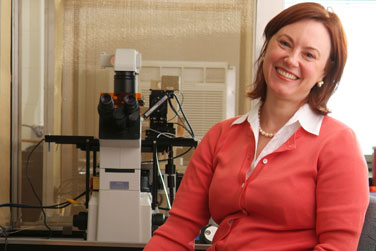Close Up
Research focuses on memory formation

Gabriela Popescu has published results of her work in major journals, including Nature. Photo: DOUGLAS LEVERE
With a team of 10 students and laboratory technicians on the sixth floor of the Biomedical Research Building on the South Campus, Gabriela Popescu is unlocking the mysteries of memory formation.
The topic of her expertise is synaptic transmission through NMDA receptors, a special type of brain protein that mediates communication between nerve cells. Her work is getting her noticed: The National Institutes of Health is funding her research, and journals including Nature and Nature Neuroscience have published her findings.
NMDA receptors have been a focus of neuroscience research in recent years, with good reason: Underactive receptors may contribute to schizophrenia, while overactive ones can kill neurons. Scientists also believe the receptors are involved in Alzheimer’s, Parkinson’s and Huntington’s diseases.
NMDA receptors are permeable to calcium ions and act like a spigot, controlling the flow of these ions into a neuron. High calcium flows stimulate memory formation. Low flows lead to forgetting. And unchecked flows can cause cell death.
In the brain, glutamate, a neurotransmitter that relays nerve impulses between neurons, will bind to an NMDA receptor, an action that leads to the opening of a channel through which calcium ions can pass. In earlier research, Popescu and UB biophysicist Anthony Auerbach modeled the receptors’ “gating” process, providing new information on events that occur after the glutamate binding. The study results appeared in Nature Neuroscience in 2003, with Popescu, then a postdoctoral fellow working under Auerbach, as lead author.
Popescu’s success continued in 2004, with a paper in Nature describing how stimulating NMDA receptors at a high frequency—about 100 times per second—can increase the strength of the connection between neurons, a quality scientists believe plays a role in memory formation.
Now, Popescu, an assistant professor of biochemistry, is working with nearly $2 million from the National Institute of Neurological Disorders and Stroke to investigate mechanisms that control NMDA receptors, information that could lead to development of drugs to treat neurological diseases. Specifically, Popescu and her research team are examining how zinc, glycine and protons— three chemicals that can bind to NMDA receptors—affect how the receptors operate.
A second grant, from the National Institute on Drug Abuse, is providing about $159,000 for Popescu to learn more about gating, to identify movements within NMDA receptors that open them to calcium flows.
Popescu’s career trajectory has been unusual. She studied biochemistry at the University of Bucharest in her native Romania and conducted research at Yale University and the University of Michigan.
But she completed both her PhD and postdoctoral research at UB, and stayed on as a faculty member, winning a tenure-track position in 2006. Her hiring was in conjunction with the strategic strength Molecular Recognition in Biological Systems and Bioinformatics identified in the UB 2020 long-range strategic plan.
She credits UB and her mentors for cultivating her as a researcher and enabling her to make major discoveries early on. She is giving back by offering students similar encouragement. One graduating doctoral candidate in her laboratory has four first-author publications and four job offers.
“My lab has been so successful, and I attribute this to continuity I had and the support that I had at every step,” Popescu says.

Reader Comments